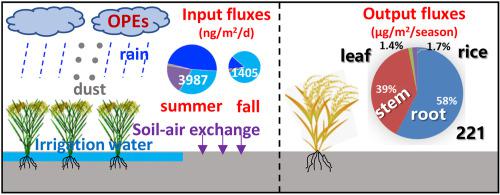Environmental Pollution ( IF 8.9 ) Pub Date : 2020-09-18 , DOI: 10.1016/j.envpol.2020.115675 Zhengen Zhang , Guolin Lin , Tian Lin , Ruijie Zhang , Lanshu Jin , Yali Di

|
Occurrence, behavior, and fate of 11 OPEs in multiple environmental matrices, which include air, rainwater, dustfall, paddy soil, irrigation water, and rice plants from nine subtropical paddy fields of South China, were investigated. The total concentrations of 11 OPEs (∑11OPEs) in all matrices are generally higher in the urban areas than in rural areas, and they are higher in summer than in fall. However, both urban and rural areas showed a similar composition profile of OPEs, indicating that the OPEs come from similar sources in the two areas. Except for irrigation water, significant positive correlations of ∑11OPEs were observed between air and the other five matrices. The exchange and partition of OPEs among air, soil, and water demonstrate that most of OPEs were transferred from air into water and soil, and from water into soil. Thus, the air may be an important source of OPEs in the paddy fields, and the soil may act as a principal environmental reservoir of OPEs. The contribution of air-soil exchange, atmospheric deposition (rainwater plus dustfall), and irrigation water to the total input fluxes of OPEs (2100 ± 980 ng/m2/day) reached an average of 19%, 38% (37% + 1%), and 43%, respectively. The water (rainwater plus irrigation water) is the primary medium transferring the OPEs into the paddy fields and contributed to the input flux by 80%. Output flux of OPEs via mature rice plants was about 220 μg/m2, 2% of which were presented in rice, and the remaining 98% may be re-released into the environment through the pathway of straw turnover or burning. Dietary exposure via rice was much higher than inhalation exposure, dust ingestion, and dermal absorption via dust. However, no data shows that all of the intakes via the four exposure pathways could cause the risks to human health at present.
中文翻译:

亚热带稻田环境中有机磷酸酯(OPE)的发生,行为和归宿-以华南南宁市为例
研究了华南9个亚热带稻田中空气,雨水,降尘,稻田土壤,灌溉水和水稻植株等多种环境基质中11种OPE的发生,行为和结局。城市中所有基质中11种OPE的总浓度(∑ 11 OPEs)通常高于农村地区,夏季高于秋季。但是,城市和农村地区的OPE构成都相似,这表明OPE的来源来自两个地区。除灌溉水外,∑ 11的正相关性在空气和其他五个矩阵之间观察到OPE。OPE在空气,土壤和水中的交换和分配表明,大多数OPE是从空气转移到水和土壤,以及从水转移到土壤的。因此,空气可能是稻田中OPE的重要来源,而土壤可能是OPE的主要环境贮藏库。空气-土壤交换,大气沉积(雨水和扬尘)和灌溉水对OPEs的总输入通量(2100±980 ng / m 2 / day)的平均贡献分别为19%,38%(37%+ 1%)和43%。水(雨水和灌溉水)是将OPEs转移到稻田中的主要介质,并贡献了80%的输入通量。通过成熟水稻植物的OPE的输出通量约为220μg/ m2,其中2%存在于大米中,其余98%可通过秸秆周转或燃烧的方式重新释放到环境中。通过大米的饮食暴露远高于吸入暴露,粉尘摄入和通过粉尘吸收皮肤。但是,目前尚无数据表明通过四个接触途径的所有摄入量都可能对人体健康造成风险。



























 京公网安备 11010802027423号
京公网安备 11010802027423号